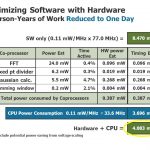Nvidia/ARM $40B. AMD/Xilinx $35B. Marvell/Inphi $10B. Despite the disruption of COVID, a wave of high value semiconductor acquisitions is sweeping the industry. Why? Did something happen that stimulated this consolidation? Until 2015, the industry was experiencing continuous “de-consolidation” that started in 1965. … Read More
Author: Wally Rhines
What’s Driving This New Wave of Semiconductor Merger Mania?
Chapter Twelve – The Future
Content of this book has focused upon predictability of trends in the semiconductor industry based upon past trends, experience and ratios. What about newly emerging applications of semiconductors? After all, the entire history of the semiconductor industry is driven by emergence of new applications.
Artificial Intelligence… Read More
Chapter Eleven – International Semiconductor Competition
Semiconductor industry evolution was largely a U.S. phenomenon. While there were important contributions made by persons all over the world, the basic technology grew from the invention of the transistor at Bell Labs which was licensed broadly in the U.S. That created a level playing field for all who wanted to become producers. … Read More
Chapter Ten – Design Automation for Systems
Electronic design automation has evolved to an extent that the complex chips with tens of billions of transistors frequently produce first pass functional prototypes from the manufacturer. What makes this so incredible is that such a small portion of the possible states of electronic operation are actually tested in the simulation… Read More
Chapter Nine – Specialization Inhibits System Level Optimization
Solving critical customer problems sometimes isn’t enough. One of my most interesting experiences came during the development and rollout of a product that was designed to optimize integration of hardware and embedded software. In this case, the product performed exactly as planned but the plan ignored the organizational… Read More
Chapter 8 – Value Through Differentiation in Semiconductor Businesses
Gross Profit Margin Percent Provides a Measure of Product Value
The difference between what customers will pay for a physical product and what it costs to make or acquire it is a good measure of differentiation. This difference divided by the revenue is the gross profit margin percent or GPM%. Once a product has an established market… Read More
Chapter 7 – Competitive Dynamics in the Electronic Design Automation Industry
Electronic design automation, or EDA, became the term used for computer software and hardware developed to aid in the design and verification of electronics, from integrated circuits to printed circuit boards to the integrated electronics of large systems like planes, trains and cars. As the EDA industry evolved, certain … Read More
Chapter 6 – Specialization in the Semiconductor Industry
Recently, the combined market share of the top ten and top twenty semiconductor companies has been increasing, contrary to the trend of the last fifty years. Given the acceleration in mergers and acquisitions that began in 2015, one might assume that, as the semiconductor industry approaches maturity, companies are consolidating… Read More
Chapter 5 – Consolidation of the Semiconductor Industry
For the last decade, semiconductor industry analysts have been writing articles and giving presentations that predict the increasing consolidation of the industry to the point where a few large companies dominate worldwide sales of semiconductor components. In recent years there has been some justification for this view… Read More
Chapter 4 – Gompertz Predicts the Future
In 1825, Benjamin Gompertz proposed a mathematical model for time series that looks like an “S-curve”.1 Mathematically it is a double exponential (Figure 1) where y=a(exp(b(exp(-ct)))) where t is time and a, b and c are adjustable coefficients that modulate the steepness of the S-Curve. The Gompertz Curve has been used for a … Read More
















Quantum Computing Technologies and Challenges